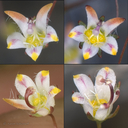notes Collage of four images of flowers from a single plant of Nemacladus tenuis, growing on a rocky bank at the edge of a desert wash. Note that these plants appear to be protandrous, meaning the anthers mature and dehisce before the stigma opens and becomes receptive to pollen. On all but the flower at lower left, you can see the whitish remains of the spent anthers (spreading to reflexed) near the top of the fused filament tube, and the freshly receptive (white, finely papillate) stigmas projecting slightly downward through the apical end of the stamen tube. In the flower at the lower left, the stigma has not yet fully extended through the tip of the stamen tube, or opened to become receptive.
You can also see some of the other fascinating structures associated with Nemacladus flowers here: the three yellow ''glands'' in the cup-shape base of the corolla; the distinct free bases of the filaments (below where they become fused into a tube above); and the fantastic, digitate and transparent ''rod-like appendages''...attached here at the end of two short stipes emanating from the bases of the lower two filaments. The yellow glands presumably secrete nectar as a reward for pollinators...but the details of the function of the transparent rod-like appendages apparently remains a (very intriguing!) mystery.
Postscript (4/26/19): 1) The transparent rod-like appendages (which I usually call ''digitate processes'', since they're palmately arranged and are actually attached to the apices of short 'true appendages' or 'stipes' at the bases of the two lower filaments) are now hypothesized to attract pollinators by simulating fully-charged nectaries with their glisten.
2) Note that the lower two photos in the collage appear there 'upside-down'. That is, the flowers in this species are ''inverted'' (or ''resupinate'')...so when properly oriented the 2-lobed lip of the corolla is 'on top' and the 3-lobed lip is 'on the bottom'. Alternatively, the flowers in those lower two photos are being viewed obliquely 'from above and behind'...whereas the flowers in the top two photos are being viewed 'straight on'.
3) Reference images by Nancy Morin for the two varieties of N. tenuis appear at this link. There can be subtleties in placing plants to variety, since there are often intermediate forms in the spectrum of variation between the extremes of N. t. var. tenuis and N. t. var. aliformis. Though somewhat intermediate, I'd place the plants here as N. t. var. tenuis due to the relatively mildly-zygomorphic corolla shape; the relatively wide & only slightly-curved frontal aspect of the upper two lobes; and the basally white and red-tipped coloration of those upper lobe. As I understand it, N. t. var. aliformis is characterized by a more strongly-zygomorphic corolla shape; with the two upper corolla lobes being significantly narrower (almost linear), more falcate, and more uniformly red throughout. For examples from the Death Valley region, see here and here.
